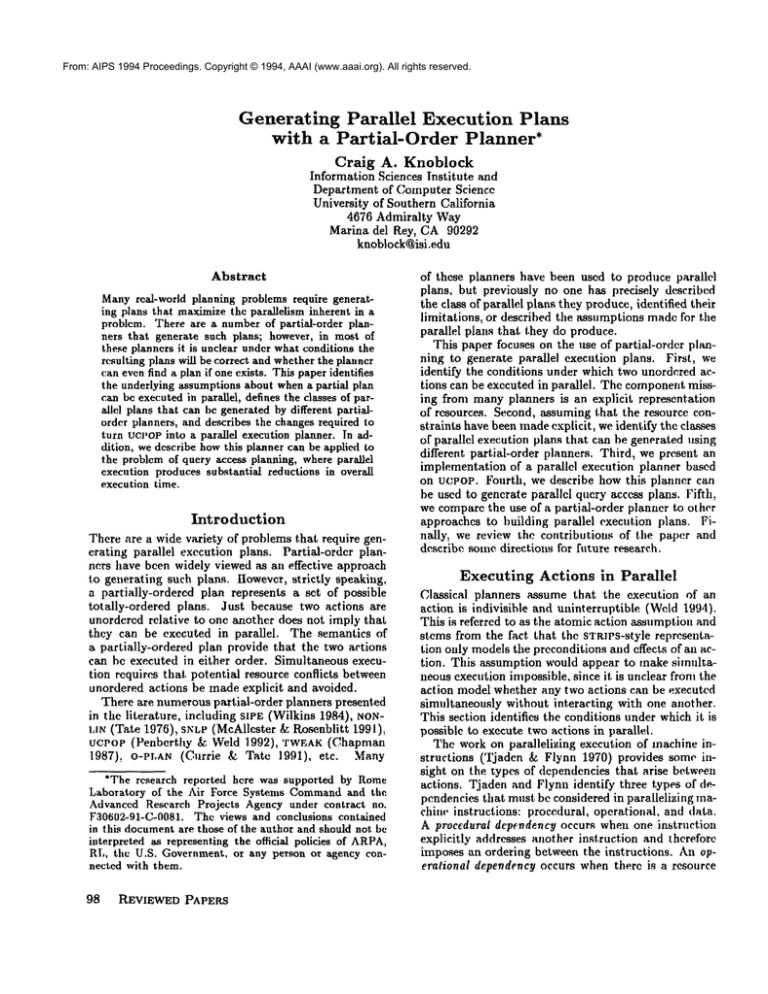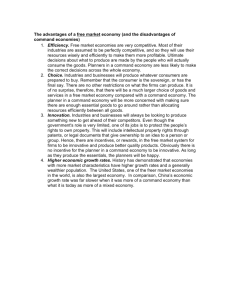
From: AIPS 1994 Proceedings. Copyright © 1994, AAAI (www.aaai.org). All rights reserved.
Generating Parallel Execution Plans
with a Partial-Order Planner*
Craig
A. Knoblock
Information Sciences Institute and
Department of Computer Science
University of Southern California
4676 Admiralty Way
Marina de] Rey, CA 90292
knoblock@isi.edu
Abstract
Manyreal-world planning problems require generating plans that maximizethe parallelism inherent in a
problem. There are a numberof partial-order planners that generate such plans; however, in most of
these planners it is unclear under what conditions the
resulting plans will be correct and whetherthe plaltner
can evenfind a plan if one exists. This paperidentifies
the underlying assumptionsabout whena partial plan
can be executedin parallel, defines the classes of parallel plans that can be generatedby different partialorder planners, and describes the changes required to
turn ucPoPinto a parallel execution planner. In "addition, we describe howthis planner can be applied to
the problemof query access planning, where parallel
execution produces substantial reductions in overall
execution time.
Introduction
There are a wide variety of problems that require generating parallel execution plans. Partial-order planners have been widely viewed as an effective approach
t.o generating such plans. Ilowevcr, strictly speaking,
a partially-ordered plan represents a set of possible
totally-ordered plans. Just because two actions are
unordered relative to one aJ~other does not imply that
they can be executed in parallel. The semantics of
a partially-ordered plan provide that the two actions
can bc executed in either order. Simultaneous execution requires that potential resource conflicts between
unordered actions be made explicit and avoided.
There arc numerous partial-order planners presented
in the literature, including SIPE (Wilkins 1984), NONLm(’rate 1976), SNLP(McAllester & Ro~nblitt 1991),
UCPOP(Penberthy &: Weld 1992), TWEAK
(Chapman
1987), O-PI,AN (Currie & ’Fate 1991), etc. Many
*The research reported here was supported by Rome
Laboratory of the Air Force Systems Commandand the
Advanced Research Projects Agency under contract no.
F30602-91-C-0081.The views and conclusions contained
in this documentare those of the author and should not be
interpreted as representing the official policies of ARPA,
RL, the U.S. Government, or any person or agency connected with them.
98
REVIEWED PAPERS
of these planners have been used to produce parallel
plans, but previously no one has precisely described
the class of parallel plans they produce, identified their
limitations, or described the assumptions made for the
parallel plans that they do produce.
This paper focuses on the use of partial-order planning to generate parallel execution plans. First, we
identify the conditions under which two unordered actions can be exccuted in parallel. The componentmissing from many planners is an explicit representation
of resources. Second, assuming that the re.source constraints have been madeexplicit, we identify the clasps
of parallel execution plans that can be generated using
different partial-order planners. Third, we present an
implementation of a parallel execution planner based
on uceoP. Fourth, we describe how this planner can
be used to gencrate parallel qucry access plans. I:’ifth,
we comparc the use of a partial-order planner to other
approaches to building parallel execution plans. Finally, we review the contributions of the paper and
describe somedirections for future research.
Executing
Actions in Parallel
Classical planners assume that the execution of an
action is indivisible and uninterruptible (Weld 1994).
This is referred to as the atomic action assumption and
stems from the fact that the S’I’RIPS-style representation only modelsthe preconditions and effects of all action. This assumption would appear to make simultaneous execution impossible, since it is unclear from the
action model whether any two actions can be executed
simvltaneously without interacting with one another.
This section identifies the conditions under which it is
possible to execute two actions in parallel.
The work on parallelizing execution of machine instructions (Tjaden & Flynn 1970) provides some insight on the types of dcpendencies that arise between
actions. Tjaden and Flynn identify three types of dependencies that must bc considered in parallelizing machine instructions: procedural, operational, and data.
A procedural dependency occurs when one instruction
explicitly addresses another instruction and therefore
imposes an ordering between the instructions. An operalional dependency occurs when there is a resource
From: AIPS 1994 Proceedings. Copyright © 1994, AAAI (www.aaai.org). All rights reserved.
associated with an instruction that is potentially unavailable. A data dependency occurs when one instruction produces a result that is used by another instruction.
Similar dependencies arise in the parallelization of
planning operations. A procedural dependency arises
when one operation is explicitly ordered after another
operation, which occurs in many of the hierarchical
planners (Tare 1976; Wilkins 1984) (e.g., see the plot
construct in SIPE). This type of constraint is captured by explicit ordering constraints between actions.
A data dependency arises when the precondition of
one operation depends on the effects of another operation. This type of dependency is captured by the
operator representation and corresponding algorithms,
which ensure that if two actions are unordered relative to one another, their preconditions and effects are
consistent. Operational dependencies can occur when
there are limited resources associated with an operation. This type of dependency is often ignored by
planning systems.
Executing actions in parallel requires explicit handling of potential resource conflicts. If two actions are
left unordered in a partial-order plan, they can be executed in either order. In order to execute them in
parallel, we must ensure that there are no potential
conflicts that occur during execution. Most conflicts
will be resolved in the process of ensuring that the
preconditions and effects are consistent. However,because of the limited representation, the type of conflict
that is not typically handled in a partial-order planner
is whentwo actions require the same reusable resource.
This type of resource conflict is not typically captured
by the preconditions and effects because at the start of
execution the resource is available and when execution
completes it is available.
Despite the problemof potential resource conflicts, a
number of partial-order planners have allowed simultaneous execution. They do so by either assuming the actions axe independent (Tare 1976), augmenting the action representation to avoid resource conflicts (Wilkins
1984), or requiring the user to explicitly represent the
conflicts in the preconditions and effects of the operators (Currie &Tate 1991). The approach of simply assuming that the actions are independent could lead to
unexpected resource conflicts. The approach of requiring the user to represent the conflicts in the preconditions and effects is both awkwardand computationally
more expensive, since it requires additional operators
that explicitly allocate and deallocate resources. The
most natural approach is to augment the action representation to describe the explicit resource needs of
the different actions. This approach was proposed in
SIPE (Wilkins 1984), where each operator can be annotated to explicitly state if something is a resource. In
the next section we will assume that the resource constraints have been made explicit and in the following
section we will describe our approach to representing
and reasoning about resources.
Parallel
Execution
Plans
This section identifies the classes of parallel execution
plans that can be generated by different planners, assuming that a domain is correctly axiomatized and
explicitly represents the resource requirements of the
operators. The different types of parallel execution
plans can be broken down into several classes, ranging from plans with completely independent actions to
those where the actions must be executed in parallel
or must overlap in a particular manner in order for
the plan to succeed. As the interactions in the plan
increase in complexity, the corresponding planners require more sophisticated representations and reasoning in order to generate such plans. In this section
we present four classes of parallel execution plans and
identify the corresponding planners that can generate
that class of plans. Theseclasses are described in order
from the most restrictive to the least restrictive.
Independent
Actions
The most restricted type of parallel execution plans are
those where all of the parallel actions are completely
independent of one another.
Twoactions are defined to be independent if and
only if the effects of the two actions executed
simultaneously are the union of the individual
effects of the actions done in isolation.
Allen (1991) notes that various partial-order planners, such as NONLIN(Tate 1976), DEVISER(Vere
1983), and SIPE (Wilkins 1984), all "allow simultaneous action when the two actions are completely independent of each other." While this statement is correct, it is a bit misleading since these planners can
generate plans for a less restrictive class of parallel
plans. As noted by Horz (1993), since some of the
effects of an operator may be unnecessary with respect
to the goal and preconditions of other operators, the
fact that two operators are unordered in a plan generated by a partial-order planner does not imply that
they are independent. A planner that can only generate plans with independent actions is UA(Minton,
Bresina, & Drummond1991), which imposes ordering
constraints between any pair of unordered actions that
could possibly interact.
Figure 1 illustrates a simplc plan with two indcpendent actions. The goal of the plan is to have the table
painted red and the chair painted blue. Since thc actions of painting the table and painting the chair are
independent, they can be executed in parallel.
Independent
Actions
Relative
to a Goal
In a variety of partial-order planners, such as SIPE
(Wilkins 1984), SNLP(McAllester & Rosenblitt 1991),
and ucPoP (Penberthy & Weld 1992), the planners
enforce the property that two actions can only remain
unordered if there is no threat between them. A threat
occurs whenan operator could potentially delete a conKNOBLOCK 99
From: AIPS 1994 Proceedings. Copyright © 1994, AAAI (www.aaai.org). All rights reserved.
HaveTab;e
Independent
Blue Chair Rl~Jh
HaveBluePair4
Figure 1: Plan With Independent Actions
dition that is relevant to achieving the final goal. 1 A
condition is defined to be relevant if and only if it is
a goal condition or a precondition of an operator that
in turn achieves a relevant condition. The class of parallel plans produced by these planners are those with
independent actions relative to the goal.
Twoactions are independent relative to a goal G if
and only if, for all conditions that are relevant
to achieving G, the result of executing the actions in either order is identical to the result
of executing the actions simultaneously.
Theseplanners are limited to this class of plans since, if
there is a threat betweenany pair of actions, additional
constraints are imposed on the plan to eliminate the
threat.
Figure 2 shows an example plan where all of the
actions are independent relative to the goal. This example differs from the independent action example in
that the two painting actions each have a side-effect
of painting the floor as well as the object. Thus, the
paint table and paint chair operators are not independent since both operations also paint the floor different
colors. IIowcver, since the color of the floor is irrelevant to the goal of getting the table painted red and
the chair painted blue, the plan is still valid and could
be generated by planners in this class.
HaveTable
RedTable
RedTable
Blue Chair. Finish
Start
HaveChair C~I1~r
Have
BluePaint BlUe Blue Floor
Figure 2: Plan with Independent Actions Relative to
the Goal
lSome planners, such as SNLP and eaxlier versions of
ucPoP, defined a threat to include aa operator that adds
or deletes a relevant condition. This stronger definition of
a threat is used to constrmn the seaxch space and would
prevent somepossible parallel plans from being generated.
I00
REVIEWED
PAPERS
Subplans Relative
to a Goal
Not all partial-order planners enforce the property that
two actions can remain unordered only if there are no
threats between them. In particular,
those planners
that implement some form of Chapman’s white knight
(Chapman1987) require only that there exist some operator that establishes a given precondition, but do not
commit to which operator. More specifically, the white
knight operation allows plans with the foIlowing conditions: There exists some operator opl that achieves a
goal or precondition g. There exists a second operator
op2 that possibly deletes g. And there exists a third
operator opa that follows op2 and achieves g. If we are
interested in producing totally-ordered plans, then the
white knight operator is not required for completeness.
However, the use of the white knight operator allows
a planner to generate a slightly more general class of
parallel plans.
The planners in this class include TWEAK(Chapman
1987), NONLIN
(rrate 1976), O-PLAN(Currie & "late
1991), MP, and MPI (Kambhampati 1994). The class
of parallel plans produced by these pla~mers are those
with independent subplans relative to a goal.
Twosubplans are independent relative to a goal G
if and only if, for all conditions that are relevant to achieving G, the result of executing the
sabplans in either order is identical to the result of executing the subplans simultaneously.
The class of parallel plans that can be generated by
the planners in this class, but cannot be generated by
the planners in the previous class are those where there
are actions that are not independent, but the subplans
in which the actions occur are independent.
Figure 3 shows an example plan with independent
subplans relative to the goal (adapted from all example in (Kambhampati1994)). In this example, before
the table and chair can be painted red, they must be
primed, and priming them has a side effect of painting
the floor white. The final goal of the problemis to get
the table, chair, and floor all painted red. Notice that
the action of priming the chair interacts with painting the table, since they both change the color of the
floor. Similarly, priming thc table interacts with painting the chair. Despite these potential interactions, the
floor will still be painted red at the end of the plan
since the table and chair must be painted after they
are primed. Solving this problem requires the white
knight operation to produce the parallel plan since the
plan does not state which painting operation will be
used to achieve the final goal of makingthe floor red.
The implementation of the white knight, which allows a planner to generate this more general class of
parallel plans, also makesit difficult’ to extend the operator language to efficiently handle more expressive
constructs, such as conditional effects and universal
quantification
(Chapman 1987). These more expressive language constructs are often required for representing and solving real problems.
From: AIPS 1994 Proceedings. Copyright © 1994, AAAI (www.aaai.org). All rights reserved.
HaveTable,,,,~ .
RedTibia
H. RedPaint.~.:: .~’~.~i:.;
FI~
"!"::’:"’""::
k::
’
HaveChai ~::..~::.~::l~med (;;hair
HavePdrn~.. .........
Red
Table~
~i.iii:.::i..
:.i:.¯
ned~,~.Etbtlh’..
Have Chair
~
HaveRedPaint..::..~.~w.’~-.. ,,,,,,,,.,,-~
, , a’,"ii~:i~r~;t~i$.~/Red
Chair
Primed
ChaiF
::::i::ii~i:i:.iii:"
Re
d Floor
Figure 3: Plan with Independent Subplans Relative to the Goal
Interacting
Actions
The most general class of parallel plans are those where
the parallel actions interact in some way. Two actions may need to be executed in parallel or two actions may need to overlap in a particular manner in
order for the plan to succeed. For example, if the final goal was to get the chair blue, the table yellow,
and the floor green and there was no green paint, we
could paint the table and chair simultaneously. To
handle these cases requires the introduction of an explicit representation of time, such as that provided
in temporal planning systems (Allen et al. 1991;
Penberthy 1993). However, in this paper we are interested in the more restricted case where we would
like to execute actions in parallel to take advantage of
the possible parallelism to reduce the total execution
time, not because the solution requires parallelism to
solve the problem.
Parallel
Execution
Planning
in UCPOP
Weused the ucpov planner (Penberthy & Weld 1992;
Barrett et al. 1993) to build a parallel execution planner. The analysis in the previous section showed that
UCPOPcan produce the class of plans with actions that
are independent relative to a goal. For the specific application described in the next section, this restriction
does not prevent the system from finding any solutions.
The changes to UCPOP that were required were to add
explicit resource definitions to the operators, to modify
the planner to enforce the resource constraints, and to
construct an evaluation functions to estimate the cost
of the parallel plans.
The resource requirements of the operators axe made
explicit by augmenting each operator with a resource
declaration. An example operator with a resource declaration is shownin Figure 4. This operator describes
the action of moving data from one data source to
another and declares the data .source from which the
data is being movedas a resource. The purpose of this
declaration is to prevent, one operator from being executed in parallel with another operator that requires
the same database.
In order to avoid resource conflicts, we modified the
planner to ensure that if two operators require the
same resource, then they are not left unordered relative to one another. In sips. this is done with a critic
(define (operator move-data)
:parameters (?dbl ?db2 ?data)
:resources ((resource ?dbl database))
:precondition (:and (available ?dbl ?data)
(:neq ?dbl ?db2))
:effect (:and (:not (available ?dbI ?data))
(available
?db2 ?data)))
Figure 4: Operator with Resource Declaration
that checks for resource conflicts and then imposes ordering constraints when conflicts are found. In ucPoP,
we added a check to the planner such that every time
a new action is added to the plan, the planner checks
for potential resource conflicts with any other operator
that could be executed in parallel. Anyconflicts discovered are added to the list of threats that must be
removedbefore the plan is considered complete. Using
the search control facility in ucPoP, these conflicts can
be resolved immediately or delayed until later in the
planning process.
Since efficiency is the primary motivation for generating parallel plans, we constructed an evaluation
function that can be used to find plans with low overall execution time. Since this evaluation function underestimates the cost of the parallel plan, the planner
can use a best-first search to find the optimal plan.
This evaluation function takes into account that the
cost of executing two actions in parallel will be the
maximumand not the sum of the costs. The space of
parallel execution plans maybe quite large, so domainspecific control knowledgemay be necessary to search
this space efficiently.
The evaluation function to determine the execution
time of a parallel execution plan is implemented using
a depth-first search. The search starts at the goal node
and recursively assigns a cost to each node in the plan.
This cost represents the total cost of execution up to
and including the action at the given node. The cost
is calculated by adding the cost of the action at the
node to the maximumcost of all the immediately prior
nodes. Once the cost of the plan up to a node has been
computed, we store this value so it will only need to
be calculated once. Since each node (n) and each edge
(e) in the graph is visited only once, the complexity
evaluating the plan cost is O(max(n,e)).
KNOBLOCK 101
From: AIPS 1994 Proceedings. Copyright © 1994, AAAI (www.aaai.org). All rights reserved.
i1~.1
~’.2H~I
ilT11S~
~ lIPID
iil
J
(emd
(notioned._ship ?ship)
(meuc_dr8~ ?ship ?dralt)
(sht_nm ?ship ?ship-type))
(end
(seepsds
?pert)
(gl¢._cd ?pwt ?gl¢._cd)
(psrt._nm ?pert ?port._n,=ms)
(cheumels ?channel)
(gl¢_cd
?chemnsl ?temp3)
(= ?temp3 ?glc._cd)
(oh depth_ft
?chemnel ?depth))
Figure 5: Parallel Query Access Plan
Parallel
Query Access Plans
There arc two general characteristics
of a dolnain
where the use of a partial-order
parMlel-execution
planner will be useful and effective. First, it is applicable to those domains where the actions could be
executed serially, but. the overall execution time can
bc reduced by exccuting some of the actions in parallel. Second, it will bc most useful in those domains
where the choice of the operations detcrmines or limits
the overall exccution time of the plan. As such, the
plan generation and scheduling cannot be done independently since this would potentially result in highly
suboptimal plans.
We. applied the parallel execution planner to a query
access planning problem that involves multiple distributed information sources (Knoblock & Arens 1994).
In this domain, a plan is produced that specifics how
to retrieve and gcnerate the requestcd set of data. This
requires selecting sourccs for the data, determining
what operations need to be performed on the data,
and deciding on the order in which to execute the operations. The planner must take into account the cost
of accessing the different information sources, the cost
of rctricving intermediate results, am| the cost of combining these interrnediate results to produce the final
results. A partial-order parallel-execution planner is
ideally suited for this problemsince the parallelization
is for efficiency purposes, and there are manypossible
plans for retrieving the same data and the choice of
plans is crucial in determining the overall efficiency.
Figure 5 shows an example parallel query-access
plan. Tim three basic query access planning operations used in this plan are move-data, join, and retrieve. The move-data operation moves a set of data
from one information source to another. The join operation combines two sets of data into a combined set
))sing the given join relations. The retrieve operation
specifies the data that is to be retrieved from a particular information source.
The domain and planner described here are fully implemented and serve as aa integral part of an information retrieval agent. Wehave also extended ucPoP to
102
REVIEWED PAPERS
perform execution, and to do so in parallel. The system is implemented and runs in Lucid CommonLisp on
SUNand HPworkstations. "Ib provide a sense for the
potential speed-up of this approach we ran a sample
query that involved queries to two different databases.
Without parallelization,
the system generated a plan
with six operators in 0.82 CPUseconds and then executed the plan in 101.8 seconds of elapsed time. With
parallelization, it generated the plan in 1.3 CPUseconds and executed the plan in 62.4 seconds of elapsed
time, a 39 percent reduction in execution time.
Related
Work
An alternative approach to addressing the problem of
simultaneous execution is provided by work on temporal planning (Allen el al. 1991; Pcnberthy 1993).
temporal planner can handle the general problem of
simultaneous parallel execution, but this general solution has a cost, since just testing the satisfiability of
a set of assertions is NP-hard (Vilaim Kautz, & van
Beek 1989). The capabilities of a full-fledged temporal planner arc necessary only if we nccd to cxplicit.ly reason about the interaction between parallel actions. In this paper wc focus on the simpler problem
of non-interacting simultaneous execution, which does
not require a full-blown temporal reasoner to handle.
In fact, partial-order planners appear to be well suited
for problemsin this class.
Another approach to this problem is to generate
totally-ordered plans and then convert each plan into
a partially-ordered plan (Veloso, Pcrez, & Carbonell
1990: Regnier & Fade 1991). The problem with this
approach is that the particular choice of the totallyordcred plan determines the parallel execution plan.
As such, in order to consider the space of parallel execution plans requires searching through the space of
totally-ordered plans. Since a single partially-ordered
plan often correspontts to a number of totally-ordered
plans, it will Im harder to efficiently search the space
of parallel cxccution plans.
Recently, Backstrom (1993)showed that thc general
problem of finding an optimal parallel cxecution plan
From: AIPS 1994 Proceedings. Copyright © 1994, AAAI (www.aaai.org). All rights reserved.
is NP-hard.
We cannotescapefromthiscomplexity
result;however,
partial-order
planners
do avoidtheNPhardsubproblern
of testing
satisfiability
andprovide
a morenaturalframework
thantotal-order
planners
forsearching
thespaceof parallel
plansandencoding
domain-specific
control
knowledge
to guidethesearch.
Discussion
The idea of using partial-order planning to generate
parallel execution plans has been around since the early
days of planning. What we have done in this paper is
to explicate the underlying assumptions and situations
where parallel execution is possible, characterize the
differences in the plans produced by various planning
algorithms, and identify the changes required to use
ucPoP as a parallel execution planner. Wehave also
shown that these ideas apply directly to the problem
of generating parallel query access plans.
In future work we plan to tightly integrate the planning and execution components. This would allow the
system to dynan]ically replan actions that fail, while
continuing to execute other actions that are "already
in progress. In addition, we plan explore the problem
of howto efficiently search the space of parallel execution plans. First, we will consider domain-independent
search strategies that produce the highest quality solution that can be found within the time allotted. Second, we will exploit domain-specific knowledgeto both
restrict the search space and guide the search.
Acknowledgments
I wouldliketo thankOrenEtzioni,
RanKanlbhampati,
KevinKnight,MilindTambe,and Dan Weldfor their
comments
andsuggestions
on earlier
draftsof thispaper.I wouldalsoliketo thankChinCheeforhishelp
in runningtheexperiments,
and DonMcKay,JanPastor,andRobinMcEntire
at Unisysfor theirhelpin
setting
up theremotedatabase
servers,
whichmadeit
possible
to runparallel
queries.
References
Allen,
J.F.;Kantz,
It.A.;Pelavin,
R. N.;andTcnenberg, J. D. 1991. Reasoning About Plans. San Mateo:
Morgan Kaufmann.
Backstrom, C. 1993. Finding least constrained
plans and optimal parMlel executions is harder
than we thought. In Current Trends in AI Planning: EWSP’g3-2nd European Workshop on Planning. Amsterdam: IOS Press.
Barrett, A.; Golden, K.; Penberthy, S.; and Weld, D.
1993. UCPOPuser’s manual (version 2.0). Technical
Report 93-09-06, Department of Computer Science
and Engineering, University of Washington.
Chapman, D. 1987. Planning for conjunctive goals.
Artificial Intelligence 32(3):333-377.
Currie, K., and Tate, A. 1991. O-Plan: The open
planning architecture. ArtificialIntelligence 52(1):4986.
Horz, A. 1993. On the relation of classical and temporal planning. In Proceedings of the Spring Symposium
on Foundations of Automatic Planning.
Kambhampati, S. 1994. Multi-contributor
causal
structures for planning: A formalization and evaluation. Artificial Intelligence.
Knoblock, C., and Arens, Y. 1994. Cooperating
agents for information retrieval. In Proceedings of
the Second International Conference on Cooperative
Information Systems. University of Toronto Press.
McAllester, D., and Rosenblitt, D. 1991. Systematic nonlinear planning. In Proceedings of the Ninth
National Conference on Artificial Intelligence.
Minton, S.; Bresina, J.; and Drummond, M. 1991.
Commitmentstrategies
in planning: A comparative
analysis. In Proceedings of the Twelfth International
Joint Conferenceon Artificial Intelligence.
Penberthy, J. S., and Weld, D. S. 1992. UCPOP:
A sound, complete, partial order planner for ADL.
In Third International Conference on Principles of
Knowledge Representation and Reasoning, 189-197.
Penberthy, J. S. 1993. Planning with Continuous
Change. Ph.D. Thesis, Department of Computer Science and Engineering, University Washington.
Regnier, P., and Fade, B. 1991. Complete determination of parallel actions and temporal optimization in
linear plans of action. In Hertzberg, J., ed., European
Workshop on Planning. Springer-Verlag. 100-111.
Tate, A. 1976. Project planning using a hierarchic
non-linear planner. Research Report 25, Depaxtmcnt
of Artificial Intelligence, University of Edinburgh,Edinburgh, Scotland.
Tjaden, G. S., and Flynn, M. J. 1970. Detection and
parallel execution of independent instructions. IEEE
Transactions on Computers C-19(10):889-895.
Veloso, M. M.; Perez, M. A.; and Carbonell, J. G.
1990. Nonlinear planning with parallel resource allocation. In Proceedings of the Workshop on Innovative Approaches to Planning, Scheduling and Control,
207-212.
Vere, S. A. 1983. Planning in time: Windowsand durations for activities and goals. IEEETransactions on
Pattern Analysis and MachineIntell. 5(3):246--267.
Vilain, M.; Kautz, H.; and van Beck, P. 1989. Constraint propagation algorithms for temporal reasoning: A revised report. In Weld, D., and de Kleer, J.,
eds., Readings in Qualitative Reasoning about Physical Systems, 373-381. Morgan Kaufmann.
Weld, D. S. 1994. An introduction to partial-order
planning. AI Magazine.
Wilkins, D. E. 1984. Domain-independent planning:
Representation and plan generation. Artificial Intelligence 22(3):269-301.
KNOBLOCK
103






